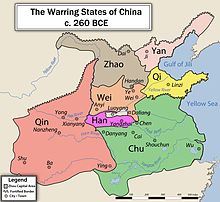
Back الدول السبعة المتحاربة Arabic Set regnes combatents Catalan شەڕی حەوت شانشینەکە CKB Sieben mächtige Fürstentümer der Zeit der Streitenden Reiche German Sep Militantaj Regnoj Esperanto هفت ایالت جنگطلب Persian Sept Royaumes combattants French 戦国七雄 Japanese 전국칠웅 Korean Sedam Zaraćenih država Serbo-Croatian

The Seven Warring States or Seven Kingdoms (traditional Chinese: 戰國七雄; simplified Chinese: 战国七雄; pinyin: zhàn guó qī xióng) were the seven leading hegemonic states during the Warring States period (c. 475 to 221 BC) of Ancient China:
During the Eastern Zhou dynasty, the weakened Zhou central sovereignty quickly lost control of its confederate vassal states, and the numerous autonomous states began overreaching and expanding their political ambitions via diplomacy and warfare, sparking a period of chaotic conflicts known as the Spring and Autumn period. After most of the smaller, weaker states are conquered and annexed by larger states, the geopolitical landscape eventually became dominated by seven most powerful states, and wars became increasingly pitched, violent and frequent. Over the Warring States period, many of the seven states underwent bureaucratic and military reforms in order to mobilise resources on a greater scale. This led to an intensification of warfare over the period, but also led to significant economic and cultural developments.
Of the Seven Warring States, the state of Qin grew to be the strongest and eventually conquered and successfully annexed the other six states; Han was the first to fall in 230 BCE, while Qi was the last to surrender in 221 BCE. Ying Zheng, the King of Qin, created the new title of Huangdi and became China's first emperor, Qin Shi Huang. The Qin state then became the Qin dynasty, and China entered its Imperial era, which lasted over the next two millennia.
© MMXXIII Rich X Search. We shall prevail. All rights reserved. Rich X Search